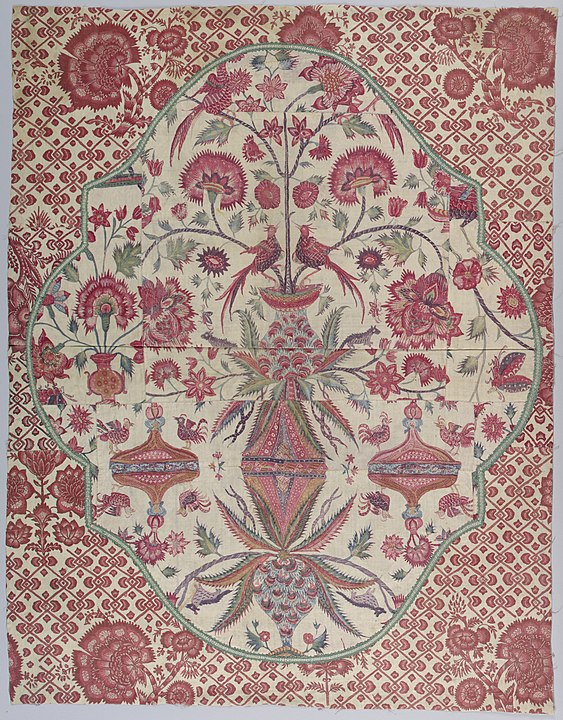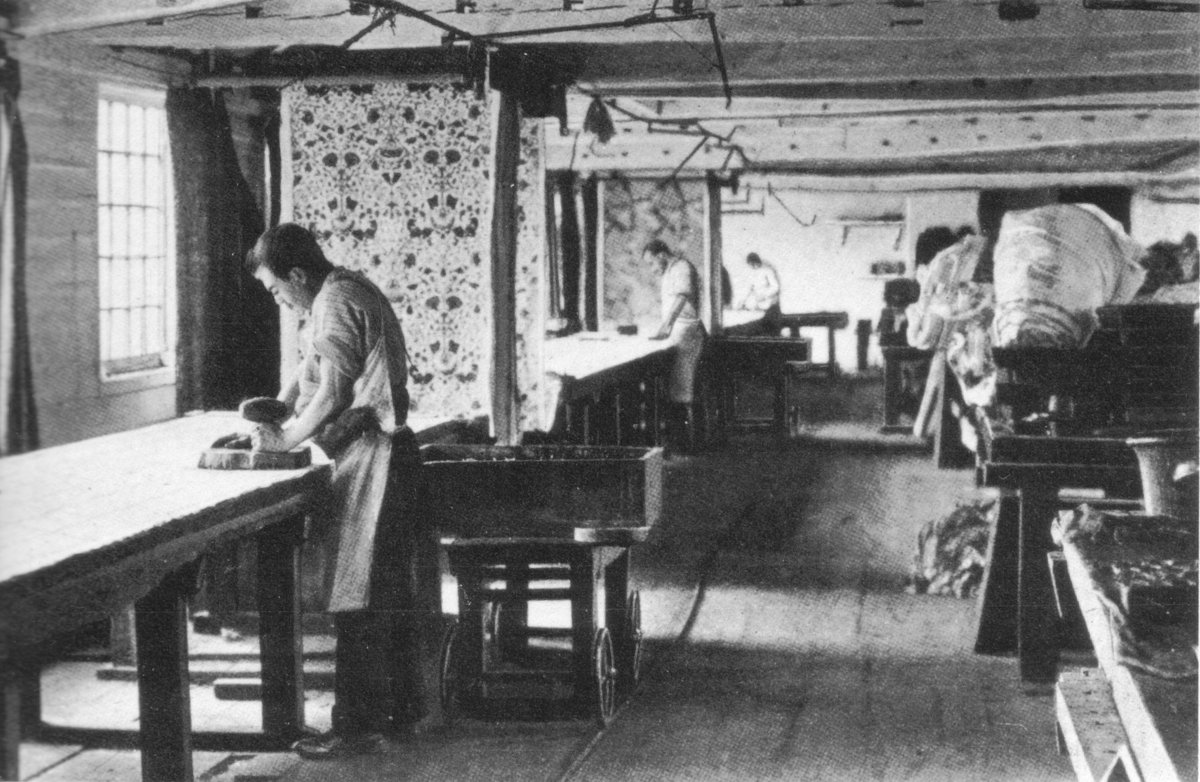
1 - So! Chintz. You've probably heard the term "chintzy" and you're thinking 1980s upholstery or prom dresses with puffy sleeves. And you're right. Sort of.
We have George Eliot to thank for the term, it turns out. But this fabric is far from European: it's from India.
We have George Eliot to thank for the term, it turns out. But this fabric is far from European: it's from India.

2 - The name comes from the Hindi word "chint" -- which means "spotted" & is a kind of calico. It was produced on cotton & printed with wood blocks or sometimes painted by hand. Some early chintz even had a glaze on it to stiffen the material (ideal for upholstery). 

3 - Some say that chinz rose to popularity in India due to Babur, the first Moghul emperor who was purported to love gardens, flowers, and nature. It was used in tapestries and furniture, & often featured red dye from dyer's madder (Rubia tinctorum) which is in the coffee family. 

4 - Chintz coloring was also applied in this order: black, red, blue, purple, yellow, and green — some applied by hand, some dip died.
Of course we have colonialism to thank for its spread to Europe. In particular, Vasco da Gama brought it back to Portugal in the late 15th C.
Of course we have colonialism to thank for its spread to Europe. In particular, Vasco da Gama brought it back to Portugal in the late 15th C.

5 - As you'd expect, Europeans were totally calm about these bold patterns. Just kidding! They called the fabric indecent for being "pagan" and "heathen."
Which naturally meant it became very popular. And that was a problem for the textile industry, especially in England.
Which naturally meant it became very popular. And that was a problem for the textile industry, especially in England.

6 - Here's where it gets wild. Fabric started outselling *spices* in terms of trade from India. And French and English textile makers were afraid they would lose business. So they started trying to curb trade and impose fines for wearing and selling the patterns. 

7 - Chintz was popular among nobles in Spain & France, but in England where it was used primarily for upholstery and home decor, it was the poorer classes who wore it, repurposing castoffs for their own fashion statements. Eventually the elite took it back because of course. 

8 - At one point, you could be punished by DEATH for smuggling or wearing chintz. And smuggling was all the rage. Because again, rich people wanted it. And of course, poor folk took the risks and the punishment. Even Queen Mary was fond of it, & Madame de Pompadour (see below) 

9 - Europeans couldn't figure out how to make it until a missionary (of course) stole the secret and sold it to Western markets. But until that point, it wasn't uncommon to be fined for wearing chintz in public.
But we're not quite done. It's time for AMERICA.
But we're not quite done. It's time for AMERICA.

10 - Though George Washington purportedly bought 96 yards of chintz for the second floor of Mt. Vernon, the US became a competitor in terms of cotton -- which is what chintz was made with. It's considered the first "mass fashion" in fact. 

11 - Once the Americans developed cotton that could withstand frost, well, story over. Sober designs starting phasing out the brighter fabrics & by the mid-19th century the craze was over.
Until the Arts & Crafts movement. Inspired by the process, Morris & Co tried their hand
Until the Arts & Crafts movement. Inspired by the process, Morris & Co tried their hand

12 - Chintz is still made in India, and just one yard of fabric can involve 8-10 people.
The 1980s married chintz and pastels. Designers like Betsey Johnson have made it a part of their repertoire. But it's hard to believe that wearing it was once illegal.
The 1980s married chintz and pastels. Designers like Betsey Johnson have made it a part of their repertoire. But it's hard to believe that wearing it was once illegal.

13 - This is why worldbuilding with fabric is so powerful. All of that over floral shapes. Racism, sexism, classism, agriculture, exploration...
Citations:
bbc.com/culture/articl…
vam.ac.uk/content/articl…
fashionheritage.eu/fascinating-te…
dutchfabric.nl/about-dutch-fa…
vam.ac.uk/blog/fabric-of…
Citations:
bbc.com/culture/articl…
vam.ac.uk/content/articl…
fashionheritage.eu/fascinating-te…
dutchfabric.nl/about-dutch-fa…
vam.ac.uk/blog/fabric-of…
• • •
Missing some Tweet in this thread? You can try to
force a refresh





